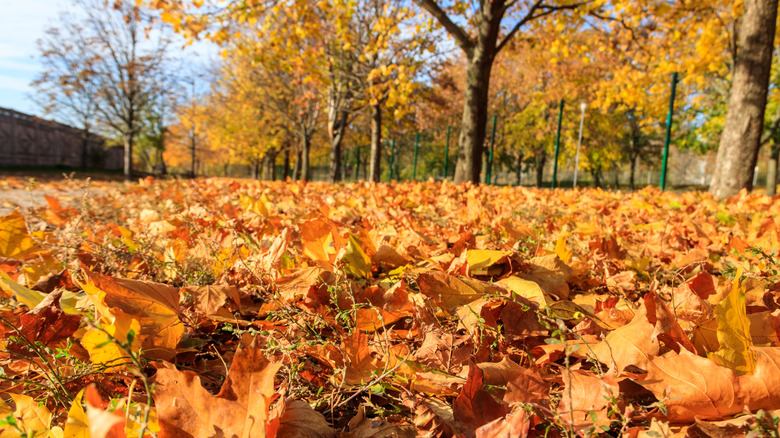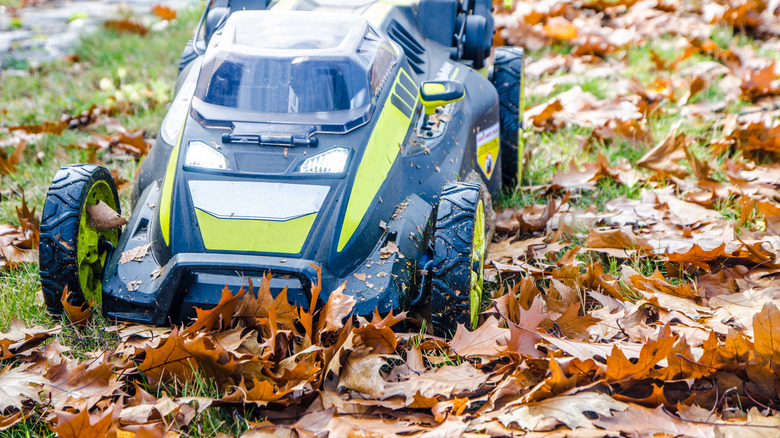For The Best Leaf-Removal Method, Consider The Type Of Tree In Your Yard
Mowing, blowing, raking, mulching, vacuuming, composting, leaving intact — leaf-removal choices could make your head spin. What if you could determine the best removal method for every kind of fall leaf on the ground in your yard? Once you really think about the trees in your landscape and their leaf characteristics, this quest is within reach. You can make leaf removal easier and more productive through shrewd botanical observations.
In the great debate over raking vs mowing the leaves in your yard, only one method reigns superior — mowing with a mulching mower, because leaf bits are left behind to decompose and nourish your yard. But not all leaves are equally easy to mow. You've probably noticed that leaves come in different textures and thicknesses. Indeed, a whole classification system describes leaf textures. You could certainly geek out on learning that tough, leathery leaves like camellia and some oak species are classified as coriaceous (or memorize the other 11 names of hairy and non-hairy leaf textures), but the important aspect of leaf characteristics is how the leaves behave with various removal methods. For example, if you run over these thick, leathery leaves with a mower, you will likely need more than one pass to shred them, whereas a single pass over thin birch leaves will likely result in instant leaf confetti.
Most of us would be happy to ditch the old-school rake and deploy easier ways to remove leaves. Let's look at ways we can apply knowledge of leaf characteristics to tackle removal while at the same time using fallen leaves to give garden soil an extra boost. Keep in mind that rakes and rake substitutes — mowers, lawn vacuums, and leaf blowers — can be called into service to assist in these removal and redistribution solutions.
Understand leaf characteristics for more efficient leaf removal
Since most kinds of leaves make great compost ingredients, you can rake up those tough, coriaceous leaves and then move that pile into your compost. Leaves with a waxy surface, like sweetgum and rhododendron, also may not shred easily and can be placed in compost, although they may not decompose as quickly as those without the waxy coating. Leaf types especially suited to composting include leaves of deciduous trees like beech, oak, maple, birch, and elm leaves.
Avoid diseased leaves, leaves treated with herbicides, and leaves with high oil content, such as poison ivy and eucalyptus. Leave black walnut leaves out of your compost, as they contain the plant-toxic chemical juglone. Pine needles can be used in small amounts but may make compost too acidic; mix needles with deciduous leaves for balanced pH. Caution: Between the time of raking leaves and placing them in the compost pile, never let the raked leaves in your lawn pile up, as you will suffocate the lawn underneath and may attract pests and disease.
In addition to using the lawn-wide method of mulching with a mower, you can also shred leaves from piles you've raked to make mulch to layer around specific plantings. Leaves cited as particularly effective as mulch overlap significantly with the deciduous leaves that are good for compost, along with ginkgo leaves, which have high mineral content. You can even till chopped leaves directly into the soil before it freezes.
Try leaf-redistribution methods that help your soil
Yet another way to get leaves out of your way in yard-friendly fashion is to make leaf mold, which you can think of as composting without the nitrogen, since leaves are carbon-heavy. The objective is decomposition, but it will be slower without the carbon/nitrogen mix that heats compost. The result will be a nutrient-rich soil amendment that can help with water retention and add microorganisms to your soil. To make leaf mold, rake or blow deciduous leaves into piles, or place them in black garbage bags or wire bins similar to compost bins (add a little moisture if using bins). Another option is to chop leaves with the mulching mower before putting them in place to decompose. If you use the garbage bag method, tie the bags shut and poke a few holes in them with a pitchfork. You'll have little to do with the molding leaves for a year or two, but do check binned leaves periodically to make sure they're not dried out.
You're probably aware of efforts in recent years to encourage gardeners to simply "leave the leaves," thus providing habitat for beneficial wildlife. Plenty of homeowners aren't in a position to follow this practice, and the "leave the leaves" movement isn't for everyone. You can still consider dispatching a few small piles of leaves for wildlife if the idea appeals to you.


